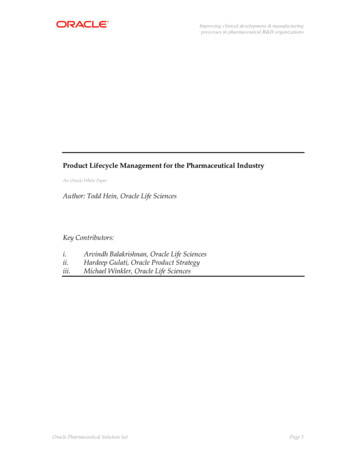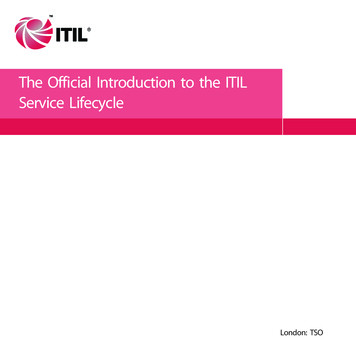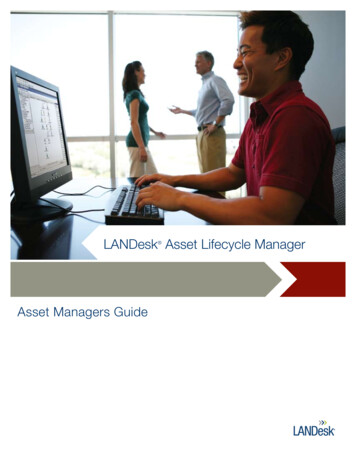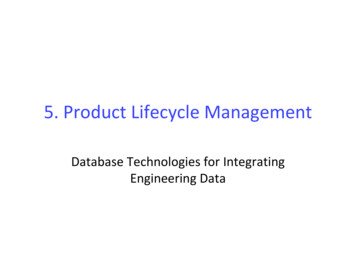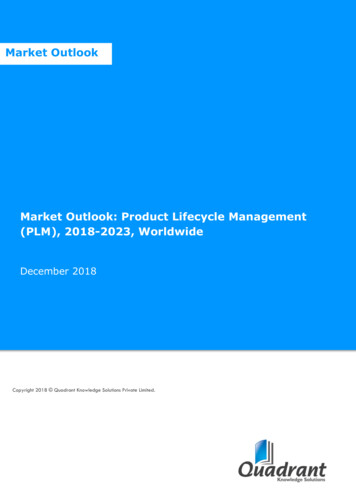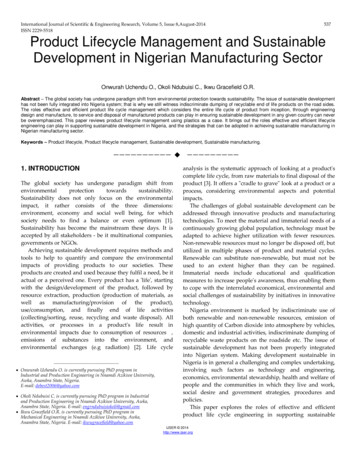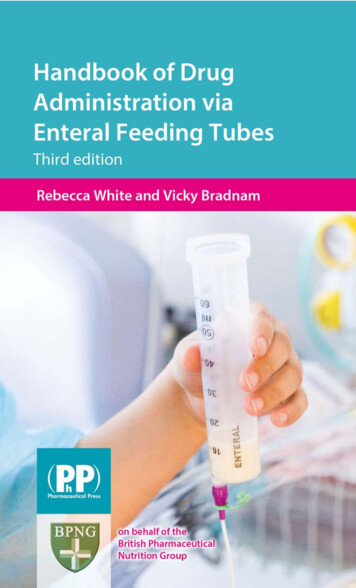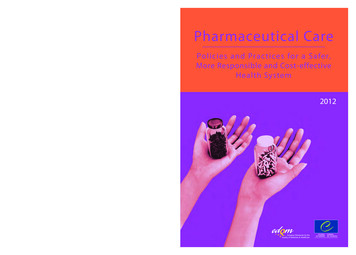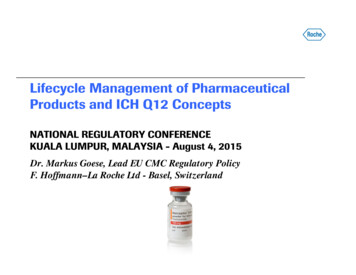
Transcription
Lifecycle Management of PharmaceuticalProducts and ICH Q12 ConceptsNATIONAL REGULATORY CONFERENCEKUALA LUMPUR, MALAYSIA - August 4, 2015Dr. Markus Goese, Lead EU CMC Regulatory PolicyF. Hoffmann–La Roche Ltd - Basel, Switzerland
Presentation Outline Challenges of global lifecycle management (LCM) Activities at ICH: Concepts of new Q12 guideline “Technical andRegulatory Considerations for Pharmaceutical Product LifecycleManagement” Reflections on situation in the region Questions & Answers
Presentation Outline Challenges of global lifecycle management (LCM) Activities at ICH: Concepts of new Q12 guideline “Technical andRegulatory Considerations for Pharmaceutical Product LifecycleManagement” Reflections on situation in the region Questions & Answers
Challenges of global lifecycle managementThe Blue Sky Vision4
MOST PHARMACEUTICAL COMPANIES AREOPERATING GLOBALLY Manufacturing sitesacross the world Global registration withHealth Authorities Global supply chain Multiple sourcing strategy5
Regulatory content differences in originalsubmission first main cause for life-cyclecomplexityExample Roche: Approximately 192 recognized stateso Activities in 140 countries Some countries accepting less detailed (CMC) informationbut Observed trend towards introduction of country-specific or regional data inother countries:o Degree of detailo Declarationso Raw datao Submission of GMP documents - “paper inspections”6
Approved details differ from country to countryafter Q&A compared to the submitted dossierSUBMISSIONPRODUCTx countriesDifferent approveddetails for one productApproval HAQ processy countriesAApproval HAQ processApproval HAQ processCPP Certificate of Pharmaceutical ProductHAQ: Health Authority Questions CPP7
LIFE CYCLE MANAGEMENT OF APHARMACEUTICAL PRODUCT Clinical: Phase 1, 2 &3 Phase 4 Formulation Delivery Site transfers CMC changes MAH transfer New onManagementPostApprovalcommitment e CTD application HA queriesmanagement Labelingdevelopment andLaunch plans Safety: PV , PSUR,safety update Stability Renewals8
Introducing changes post-approval is anessential part of the lifecycle of a medicinalproduct Ensure market access and continuous supply of livesaving drugs to patients by reacting to supply demands Support continuous improvement and optimization ofmanufacturing process and quality of the medicinal products Remain state-of-the-art with manufacturing methods andanalytical techniques Fulfill increasing regulatory agency requirements9
Bringing a post–approval change throughthe global systems can take years*DocReview TimeCore ICH countries4-10 MonthsICH-like countriesCPP countriesReview TimeDoc6-20 MonthsDoc0Review Time6-24 MonthsTime (months)* example: manufacturing site-transfer for a biologic drug substance4810
Approved details differ from country to countryafter Q&A compared to the submitted dossierChanges add significantly to the complexitySUBMISSIONx countriesPRODUCTAApproval HAQCHANGE 1y countriesApproval HAQApproval HAQ CPP11
Challenges to submit post-approval changesgloballyChangeclassificationsdifferent or notavailable*Country-specificrequirements (e.g.,stability, raw data)Complex supplyplanning/ highbridging stocksLong/unpredictableapproval timelinesBacklog due to high reviewdemand at HealthAuthoritiesCPP** orreferenceapproval neededfor submission?Drug shortageHinder innovation andcontinual improvementof process and productQuality and safety Need to Reflect on pragmatic solutions* Missing opportunities for Bundling, Annual Report and streamlining between different variation applications and renewal** CPP Certificate of Pharmaceutical Product12
Key pillars to facilitate implementation of postapproval changes globally Change Classification concept Procedural guidance incl. timelines Documentation and data requirements (remove GMP elements)Risk based approach (biotech example):Richard Lit APEC 201313
Examples for guidelines on handling changes/variations to an approved dossier(currently for chemical drugs and vaccines)oWHOoEMA/ European Commision (EC)oUS-FDAoJapan/ PMDAoASEANfor chemical drugsand large molecules/biologics(currently for chemical drugs only)14
Comparison of regional change AN«PRIORAPPROVAL»Type geApplication(PCA)Major Variation VmajType II Major VariationMaV«TELL,WAIT & DO»Type IBVariationChangesbeingeffected in30 days(CBE-30)Minor Variation VminType I - MinorVariation-PriorApprovalMiV-PA«TELL &DO»Type ificationIN«DO &TELL»Type IAVariationAnnualReport (AR)ModerateLowerMinorchangeNotification(MCN), withinAnnual NotificationANType I - Minorvariation-NotificationMiV-N30 days afterimplementation/shipping15
Roche supporting efforts for harmonization atregional and global levelsGlobalRegulatorystandards Improvements in supply,quality and safety Better outcomes forpatients Global access forinnovativepharmaceuticals16
Presentation Outline Challenges of global lifecycle management (LCM) Activities at ICH: Concepts of new Q12 guideline “Technical andRegulatory Considerations for Pharmaceutical Product LifecycleManagement” Reflections on situation in the region Questions & Answers
LifeCycle* Management: What is needed? Desired stateA system that facilitates managing quality changes and continualimprovement throughout the whole product lifecycle with anemphasis on post-approval/ commercial manufacturing*Product and Process LifeCycle:Pharmaceutical Development Technology Transfer CommercialManufacturing Product Discontinuation18
ICH Quality Guidelines incl. Q12Q1-Q7: «Basic»Quality guidelinesQ8-Q11: New QualityParadigm/ «EnhancedApproach» / QbDQ12: New ICH Quality Topic19
ICH Q12 – Technical and Regulatory Considerationsfor Pharmaceutical Product Lifecycle Management ICH Q12 Expert Working Group Diversity of technical expertise (small and large molecule,development, manufacturing, quality and regulatory, assessors andinspectors) Good collaboration, team commits to address difficult topics Q12 EWG team members (current status):o EU/EMA, EFPIA, Swissmedic, APIC, FDA, PhRMA, HealthCanada, IGPA, BIO, MHLW/PMDA, JPMA, WHO, WSMI,DoH Chinese Taipei, DRA Singapore Scope of the Q12 Guideline: All pharmaceutical products includingcurrently marketed chemical, biotechnological and biological products20
How can ICH Q12 help to address thechallenges mentioned before? Clarifying established conditions for manufacture and control basedon risk, product type, development approaches, manufacturingexperience, GMP status Development of product lifecycle strategy Provide harmonized tools to facilitate prospective changes over theproduct lifecycle, e.g. change management protocols Establish ICH expectations of assessment and implementation offrequent manufacturing changes21
Example “Established Conditions” in Japan: Relationshipbetween Application Form (AF) and CTD Documents(1/2)Approved MattersModule 1(Application Form) Composition Mfg. process incl.control of materials Specification Storage condition,Shelf life Mfg. sites inf. Etc.Major review documentModule 2 (QOS)Module 3Yasuhiro Kishioka APEC 201522
Example “Established Conditions” in Japan: Relationshipbetween Application Form (AF) and CTD Documents(2/2)Legally binding Partial Change Application (PCN; for major changes) Minor Change Notification (MCN; for minor changes)Module 1 (AF)Module 2 (QOS)Module 3Not-Changeable without regulatoryprocedures (PCA/MCN)Yasuhiro Kishioka APEC 2015Changeable without regulatoryprocedures (PCA/MCN)23
Established Conditions/ Regulatorycommitments for Manufacture and Control Despite ICH M4/ CTD being in place for the marketing authorizationapplication in the ICH regions: there is no harmonized understanding/ approaches to definingwhich information in the dossier is binding and therefore requiresa post-approval regulatory action when it is changed Important: defining “Regulatory Commitments/ Approved Matters/Established Conditions” to clarify binding information andsupportive details in dossier Working definition of ‘Regulatory commitment/ Approved Matters/ EstablishedCondition’ drafted in Q12 EWG, to be further discussed and improved: “ certain binding information concerning the manufacture and control including description of the product, manufacturing process, facilities,specifications and other elements of the associated control strategy (e.g.storage conditions or shelf-life)” CTD sections containing regulatory commitments identified24
Comparability Protocols (CPs)/ Post-approvalchange management protocols (PACMPs) US-FDA issued „Draft Guidance forIndustry Comparability Protocols Chemistry, Manufacturing, andControls” in 2003 (based on ICHQ5E) EU introduced Post-approvalchange management protocols(PACMPs) in 2010 Overall, EU-PACMP and US-CPconcept very similar; goodstarting point for ICH Q1225
Post Approval Change Management protocols(PACMPs): Definition – EU example A PACMP is a regulatory tool that describes specificchange(s) that a company would like to implementfollowing marketing authorization and how these would beprepared and verified A PACMP applies to all types of products andincorporates a science and risk-based approach toevaluate impact of change(s) on product quality in aproactive manner PACMPs may be included in an original marketingauthorization application (MAA) or be submitted as astand-alone type II-variation; approved PACMPs can bemodified via a type II (major change) or type IB (minorchange) variation26
The principle of the Change ManagementProtocol: a 2-step implementation approach«traditional» approachwithout PACMP:with PACMP:Source: EMA Questions and Answers on post-approval change management protocols27
Example (EU): Biologics DS manufacturing site transfer Benefit of PACMP Approach vs. „Traditional“ Approach*PACMP 3-5 months faster approval ofthe site change using a PACMP*Note: approval timelines for type II variation in this scheme include positive CHMP opinion and Commission Decision28
Why use a PACMP/ CP approach? Benefits:– Expedited review and/or inspection at step 2 of PACMPprocedure– Reduced category for future reporting of CMC changescovered by the approved protocol (but type IB default forbiologics in EU)– Predictability and transparency in terms of requirementsand studies needed to implement a change (approved protocolis an agreement between the sponsor and the HA)– Faster implementation, if the pre-determined criteria of thePACMP are met; use of the PACMP could allow an applicant toplace a product in distribution sooner29
Rest ofWorldUSAJapanEUCanadaOpportunities: Enablers &Tools for ChangesSwitzerlandSummary ICH Q12 - Opportunities forHarmonization and anticipated benefitsRegulatory Oversight of All Changes(Assessment of Variations orGMP Inspection of PQS Change Management System)Clearly defined Regulatory Commitments/ApprovedMatters/Established Conditions (in Dossier)?Harmonized Post-Approval Change ManagementProtocolsBENEFITSTiered, Risk-based Regulatory Framework forAssessment of Variations to Marketing AuthorisationsFor Regulators: Facilitates appropriate, risk-basedincreased efficiencyregulatory oversight;For Industry: Increased manufacturing efficiency and opportunities for innovation& improvementFor Patients: Better availability and reliability of the supply of high qualitypharmaceuticals30
Presentation Outline Challenges of global lifecycle management (LCM) Activities at ICH: Concepts of new Q12 guideline “Technical andRegulatory Considerations for Pharmaceutical Product LifecycleManagement” Reflections on situation in the region Questions & Answers
Reflections on situation in the region/ ASEAN The lifecycle management was traditionally managed by renewalsystem After implementation of post-approval variation guidance(which is based on science and risk-based approach) the renewalsystem continues to exist Reflection: Consider optimal operation for lifecycle managementwhich is streamlined, non-duplicating and effective in protectingpatients' safety to achieve:(1) optimal management of large volume of applicationswithout duplication(2) Timely access of products to patients in need.32
Global convergence of Lifecycle Managementfor Biotherapeutics – recent WHO activitiesFebruary 2014:May 2014 (Seoul meeting):- IFPMA established a positionpaper on post-approval changerequirements- Post-approval change management becomeshigh priority topic- Procedural guidance forBiotherapeutics- Guidelines for procedures and data requirements for changes to approved vaccines adoptedOctober 2014 (Geneva): High priority to build Biotherapeutics variation guidelines based on the existingvaccines principles as: Addition of an Annex to the WHO Guidelines on the quality, safety, and efficacy ofbiotherapeutic protein products prepared by recombinant DNA or As a standalone documentIFPMA: International Federation of Pharmaceutical Manufacturers & Associations33
The WHO Guideline for Changes to Approved Vaccinesmay provide the Best Opportunity for ImplementingGlobal Post-Approval Variation Requirements ofBiotherapeutics34
Extract from WHO guideline for changes to approvedvaccines2. INTRODUCTION/ SCOPEThis document provides guidance for NRAs and MA holders on the regulationof changes to the original MA dossier or product licence for an approvedvaccine in terms of: (a) procedures and criteria for the appropriatecategorization and reporting of changes; and (b) the data required to enableNRAs to evaluate the impact of the change on the quality, safety and efficacyof the vaccine.Additionally, the purpose of these WHO Guidelines is to assist NRAs inestablishing regulatory procedures for post-approval changes to vaccines.The guidance given below applies to the manufacture and use ofapproved prophylactic vaccines for humans. However, the general principlesset out in this document may also apply to other biological products. Proposal to expand the scope of the guideline toBiotherapeutic products (prepared by rDNA technology)35
Extract from WHO guideline for changes to approvedvaccinesClear, risk-based procedural guidance and review timelines ality ChangesMajor QualityChangesSignificant potential to have an impact on Quality; Safety; 6 monthsEfficacyPrior Approval Supplement (PAS)ModerateQuality ChangesModerate Potential to have an impact on Q;S;EPrior Approval Supplement (PAS)3 monthsMinor QualityChangesMinimal Potential to have an impact on Q;S;EDo not require notification to the NRA 1N/A1 Minor quality changes that are related to a moderate or major quality change should be included in the PAS if they have beenimplemented after the submission of a previous supplement for a moderate or major quality change.36
Extract from WHO guideline for changes to approvedvaccinesDetailed dossier requirements are provided, e.g. for the drug substanceand the final productKey elements for biotherapeuticsdrug substance and drug producthave to be included: Adapt description of relevantchanges Adapt the respective conditions Adapt the respective supportingdata for a given change, e.g. batchanalysis data, stability standards(e.g., accelerated stability studies not more than 6 months real-timedata to maintain shelf-life.)37
Important Update from latest APECmeeting June 2015 in Korea Public commitment from WHO to pursue thedevelopment of a global guidance for post-approvalvariations for Biotherapeutics based on the vaccineprinciples Addition of an Annex to rDNA guideline or as a standalone document Document expected late 2016/ early 201738
Reflections on situation in the region/ ASEAN, cont’d Some proposals to make a link to the conceptsoutlined in this presentation: With the ASEAN variation guideline now in place, the renewalsystem should be purely administrative (cf. example EU, Singapore) Industry should commit to timely, comprehensive variationsubmissions of high quality HAs should ensure variations are managed through transparentguidance (comprising clear procedures [timelines], classification,documentation and data requirements -- see WHO example) Interaction between industry and regulators should be builton trust and sharing responsibility – in the collaborative spiritof ICH Q12.39
Acknowledgements Susanne Ausborn, Roche Wassim Nashabeh, Roche Ralf Gleixner, Roche Thomas Schreitmueller, Roche Kowid Ho, Roche Fabienne Chapalain, Roche Bianca Omasreiter, Roche Sannie Chong, Roche Ai Ling Woo, Sheen Wei Wong; Roche Malaysia ICH Q12 EWG colleagues, especially Yasuhiro Kishioka, PMDA40
Thank you very much!Questions?41
Doing now what patients need next
on risk, product type, development approaches, manufacturing experience, GMP status Development of product lifecycle strategy Provide harmonized tools to facilitate prospective changes over the product lifecycle, e.g. change management protocols Establish ICH expectations of as
